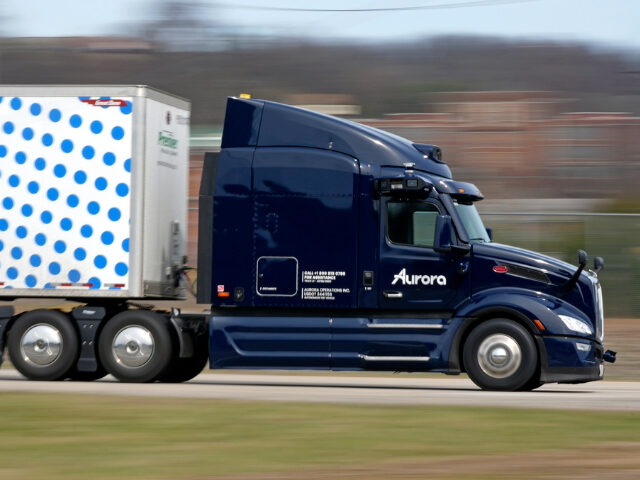“Tens of thousands” of fully autonomous tractor-trailers are expected to haul freight on public roads in upcoming years, and plans are in place to begin with 20 driverless trucks in Texas in 2024.
Aurora Innovation Inc., a Pittsburgh, Pennsylvania-based company looking to innovate autonomous driving technology, has been running controlled tests on 18-wheelers to safely get them onto freeways before its competitors, CBS News reports.
With 25 laser, radar, and camera sensors, the truck can “see” obstacles in the road from a quarter-mile out and then switch to an unobstructed lane without any instruction or manipulation from a human.
Since 2021, Aurora trucks have autonomously hauled freight more than one million miles on public highways with human safety drivers on board. There have been only three crashes, Aurora CEO Chris Urmson said, all caused by mistakes made by human drivers in other vehicles.
“Within three or four years, Aurora and its competitors expect to put thousands [of] self-driving trucks on America’s public freeways,” the outlet stated. “The goal is for the trucks, which can run nearly around the clock without breaks, to speed the flow of goods, accelerating delivery times.”
Though the test runs have only been on simulated roads at lower speeds or public roads with human failsafe operators on board, Aurora plans to transport loads on Texas’s Interstate 45 between Dallas and Houston with 20 driverless trucks by the end of 2024.
“We want to be out there with thousands or tens of thousands of trucks on the road,” said Urmson. “And to do that, we have to be safe. It’s the only way that the public will accept it. Frankly, it’s the only way our customers will accept it.”

A worker directs an Aurora Innovation Inc. driverless truck at the company’s terminal in Palmer, Texas, on December 28, 2023. (Dylan Hollingsworth/Bloomberg via Getty Images)
Self-driving technology has existed in various forms from auto manufacturers like Tesla and Waymo, but Aurora is racing to be the first to spread autonomization to the long-haul trucking industry before competing companies, such as Plus.ai, Gatik, and Kodiak Robotics.
Gatik has reported its expectations of beginning in 2024 or 2025, while the others have yet to release their timetables, according to CBS.
While the technology makes advances, the average American’s mindset towards 80,000 pounds driving 65 mph down super-highways may not be one of acceptance just yet.
According to AAA’s latest survey on the subject, most U.S. drivers either express fear (66 percent) or uncertainty (25 percent) about fully driverless vehicles.
Safety advocates have also been pointing out that “almost no federal regulation” is currently on the books for autonomous cars and trucks, so, as of now, it is up to the developers to determine if the vehicles are safe enough to operate, CBS reported.
Phil Koopman, a Carnegie Mellon University professor who studies software and autonomous vehicle safety, theorizes that these trucks can be safer but warns that the computer systems will inevitably make mistakes.
With billions of dollars in investments on the line, Koopman wonders how companies will responsibly make safety decisions.
“Everything I see indicates they’re trying to do the right thing,” he said. “But the devil is in the details.”
According to Urmson, Aurora is not in the business of compromising safety in order to make money. The company is not even expected to turn a profit until late 2027 or early 2028.
“If we put a vehicle on the road that isn’t sufficiently safe — that we aren’t confident in the safety of — then it kills everything else,” the CEO said publicly in March.
He also predicted that driverless trucks will complement human drivers, not replace them.
“If you’re driving a truck today,” said Urmson, “my expectation is you’re going to be able to retire driving a truck.”

COMMENTS
Please let us know if you're having issues with commenting.